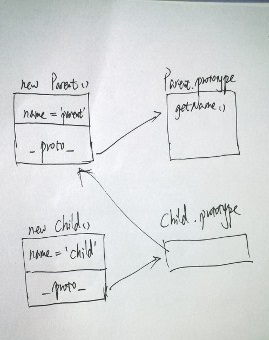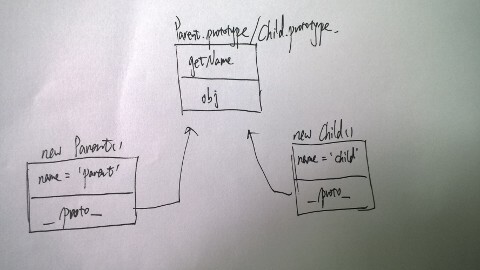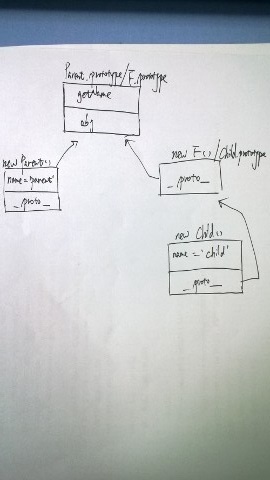原型与原型链
说原型继承之前还是要先说说原型和原型链,毕竟这是实现原型继承的基础。
在Javascript中,每个函数都有一个原型属性prototype指向自身的原型,而由这个函数创建的对象也有一个__proto__属性指向这个原型,而函数的原型是一个对象,所以这个对象也会有一个__proto__指向自己的原型,这样逐层深入直到Object对象的原型,这样就形成了原型链。下面这张图很好的解释了Javascript中的原型和原型链的关系。

每个函数都是Function函数创建的对象,所以每个函数也有一个__proto__属性指向Function函数的原型。这里需要指出的是,真正形成原型链的是每个对象的__proto__属性,而不是函数的prototype属性,这是很重要的。
原型继承
基本模式
var Parent = function(){
this.name = 'parent' ;
} ;
Parent.prototype.getName = function(){
return this.name ;
} ;
Parent.prototype.obj = {a : 1} ;
var Child = function(){
this.name = 'child' ;
} ;
Child.prototype = new Parent() ;
var parent = new Parent() ;
var child = new Child() ;
console.log(parent.getName()) ; //parent
console.log(child.getName()) ; //child
这种是最简单实现原型继承的方法,直接把父类的对象赋值给子类构造函数的原型,这样子类的对象就可以访问到父类以及父类构造函数的prototype中的属性。 这种方法的原型继承图如下:

这种方法的优点很明显,实现十分简单,不需要任何特殊的操作;同时缺点也很明显,如果子类需要做跟父类构造函数中相同的初始化动作,那么就得在子类构造函数中再重复一遍父类中的操作:
var Parent = function(name){
this.name = name || 'parent' ;
} ;
Parent.prototype.getName = function(){
return this.name ;
} ;
Parent.prototype.obj = {a : 1} ;
var Child = function(name){
this.name = name || 'child' ;
} ;
Child.prototype = new Parent() ;
var parent = new Parent('myParent') ;
var child = new Child('myChild') ;
console.log(parent.getName()) ; //myParent
console.log(child.getName()) ; //myChild
上面这种情况还只是需要初始化name属性,如果初始化工作不断增加,这种方式是很不方便的。因此就有了下面一种改进的方式。
借用构造函数
var Parent = function(name){
this.name = name || 'parent' ;
} ;
Parent.prototype.getName = function(){
return this.name ;
} ;
Parent.prototype.obj = {a : 1} ;
var Child = function(name){
Parent.apply(this,arguments) ;
} ;
Child.prototype = new Parent() ;
var parent = new Parent('myParent') ;
var child = new Child('myChild') ;
console.log(parent.getName()) ; //myParent
console.log(child.getName()) ; //myChild
上面这种方法在子类构造函数中通过apply调用父类的构造函数来进行相同的初始化工作,这样不管父类中做了多少初始化工作,子类也可以执行同样的初始化工作。但是上面这种实现还存在一个问题,父类构造函数被执行了两次,一次是在子类构造函数中,一次在赋值子类原型时,这是很多余的,所以我们还需要做一个改进:
var Parent = function(name){
this.name = name || 'parent' ;
} ;
Parent.prototype.getName = function(){
return this.name ;
} ;
Parent.prototype.obj = {a : 1} ;
var Child = function(name){
Parent.apply(this,arguments) ;
} ;
Child.prototype = Parent.prototype ;
var parent = new Parent('myParent') ;
var child = new Child('myChild') ;
console.log(parent.getName()) ; //myParent
console.log(child.getName()) ; //myChild
这样我们就只需要在子类构造函数中执行一次父类的构造函数,同时又可以继承父类原型中的属性,这也比较符合原型的初衷,就是把需要复用的内容放在原型中,我们也只是继承了原型中可复用的内容。上面这种方式的原型图如下:

临时构造函数模式(圣杯模式)
上面借用构造函数模式最后改进的版本还是存在问题,它把父类的原型直接赋值给子类的原型,这就会造成一个问题,就是如果对子类的原型做了修改,那么这个修改同时也会影响到父类的原型,进而影响父类对象,这个肯定不是大家所希望看到的。为了解决这个问题就有了临时构造函数模式。
var Parent = function(name){
this.name = name || 'parent' ;
} ;
Parent.prototype.getName = function(){
return this.name ;
} ;
Parent.prototype.obj = {a : 1} ;
var Child = function(name){
Parent.apply(this,arguments) ;
} ;
var F = new Function(){} ;
F.prototype = Parent.prototype ;
Child.prototype = new F() ;
var parent = new Parent('myParent') ;
var child = new Child('myChild') ;
console.log(parent.getName()) ; //myParent
console.log(child.getName()) ; //myChild
该方法的原型继承图如下:

很容易可以看出,通过在父类原型和子类原型之间加入一个临时的构造函数F,切断了子类原型和父类原型之间的联系,这样当子类原型做修改时就不会影响到父类原型。
我的方法
《Javascript模式》中到圣杯模式就结束了,可是不管上面哪一种方法都有一个不容易被发现的问题。大家可以看到我在'Parent'的prototype属性中加入了一个obj对象字面量属性,但是一直都没有用。我们在圣杯模式的基础上来看看下面这种情况:
var Parent = function(name){
this.name = name || 'parent' ;
} ;
Parent.prototype.getName = function(){
return this.name ;
} ;
Parent.prototype.obj = {a : 1} ;
var Child = function(name){
Parent.apply(this,arguments) ;
} ;
var F = new Function(){} ;
F.prototype = Parent.prototype ;
Child.prototype = new F() ;
var parent = new Parent('myParent') ;
var child = new Child('myChild') ;
console.log(child.obj.a) ; //1
console.log(parent.obj.a) ; //1
child.obj.a = 2 ;
console.log(child.obj.a) ; //2
console.log(parent.obj.a) ; //2
在上面这种情况中,当我修改child对象obj.a的时候,同时父类的原型中的obj.a也会被修改,这就发生了和共享原型同样的问题。出现这个情况是因为当访问child.obj.a的时候,我们会沿着原型链一直找到父类的prototype中,然后找到了obj属性,然后对obj.a进行修改。再看看下面这种情况:
var Parent = function(name){
this.name = name || 'parent' ;
} ;
Parent.prototype.getName = function(){
return this.name ;
} ;
Parent.prototype.obj = {a : 1} ;
var Child = function(name){
Parent.apply(this,arguments) ;
} ;
var F = new Function(){} ;
F.prototype = Parent.prototype ;
Child.prototype = new F() ;
var parent = new Parent('myParent') ;
var child = new Child('myChild') ;
console.log(child.obj.a) ; //1
console.log(parent.obj.a) ; //1
child.obj.a = 2 ;
console.log(child.obj.a) ; //2
console.log(parent.obj.a) ; //2
这里有一个关键的问题,当对象访问原型中的属性时,原型中的属性对于对象来说是只读的,也就是说child对象可以读取obj对象,但是无法修改原型中obj对象引用,所以当child修改obj的时候并不会对原型中的obj产生影响,它只是在自身对象添加了一个obj属性,覆盖了父类原型中的obj属性。而当child对象修改obj.a时,它先读取了原型中obj的引用,这时候child.obj和Parent.prototype.obj是指向同一个对象的,所以child对obj.a的修改会影响到Parent.prototype.obj.a的值,进而影响父类的对象。AngularJS中关于$scope嵌套的继承方式就是模范Javasript中的原型继承来实现的。
根据上面的描述,只要子类对象中访问到的原型跟父类原型是同一个对象,那么就会出现上面这种情况,所以我们可以对父类原型进行拷贝然后再赋值给子类原型,这样当子类修改原型中的属性时就只是修改父类原型的一个拷贝,并不会影响到父类原型。具体实现如下:
var deepClone = function(source,target){
source = source || {} ;
var toStr = Object.prototype.toString ,
arrStr = '[object array]' ;
for(var i in source){
if(source.hasOwnProperty(i)){
var item = source[i] ;
if(typeof item === 'object'){
target[i] = (toStr.apply(item).toLowerCase() === arrStr) : [] ? {} ;
deepClone(item,target[i]) ;
}else{
deepClone(item,target[i]) ;
}
}
}
return target ;
} ;
var Parent = function(name){
this.name = name || 'parent' ;
} ;
Parent.prototype.getName = function(){
return this.name ;
} ;
Parent.prototype.obj = {a : '1'} ;
var Child = function(name){
Parent.apply(this,arguments) ;
} ;
Child.prototype = deepClone(Parent.prototype) ;
var child = new Child('child') ;
var parent = new Parent('parent') ;
console.log(child.obj.a) ; //1
console.log(parent.obj.a) ; //1
child.obj.a = '2' ;
console.log(child.obj.a) ; //2
console.log(parent.obj.a) ; //1
综合上面所有的考虑,Javascript继承的具体实现如下,这里只考虑了Child和Parent都是函数的情况下:
var deepClone = function(source,target){
source = source || {} ;
var toStr = Object.prototype.toString ,
arrStr = '[object array]' ;
for(var i in source){
if(source.hasOwnProperty(i)){
var item = source[i] ;
if(typeof item === 'object'){
target[i] = (toStr.apply(item).toLowerCase() === arrStr) : [] ? {} ;
deepClone(item,target[i]) ;
}else{
deepClone(item,target[i]) ;
}
}
}
return target ;
} ;
var extend = function(Parent,Child){
Child = Child || function(){} ;
if(Parent === undefined)
return Child ;
//借用父类构造函数
Child = function(){
Parent.apply(this,argument) ;
} ;
//通过深拷贝继承父类原型
Child.prototype = deepClone(Parent.prototype) ;
//重置constructor属性
Child.prototype.constructor = Child ;
} ;
总结
说了这么多,其实Javascript中实现继承是十分灵活多样的,并没有一种最好的方法,需要根据不同的需求实现不同方式的继承,最重要的是要理解Javascript中实现继承的原理,也就是原型和原型链的问题,只要理解了这些,自己实现继承就可以游刃有余。


















